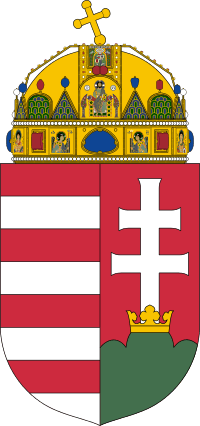Hungary–Romania relations
 |
|
Hungary |
Romania |
|---|---|
Hungarian-Romanian relations are foreign relations between Hungary and Romania. Relations between the two states date back from the Middle Ages. Both countries established diplomatic relations in 1920. Even so, historic conflicts still live inside both nations as they claim disputed territory as their own, notably Transylvania.
Bilateral relations
Hungary has an embassy in Bucharest, three general consulates (in Cluj-Napoca, Miercurea-Ciuc and Constanța) and three honorary consulates (in Constanța, Iași and Drobeta-Turnu Severin).[1] Romania has an embassy in Budapest and two general consulates (in Gyula and Szeged). The two countries share 443 km of common border. Both are full members of NATO and of the European Union.
Romania has developed strong relations with Hungary, with the latter playing a key role in supporting Romania's bid to join the EU. Romania's ethnic Hungarian party also participated in all the government coalitions between 1996 and 2008 and from 2009. In 1996, Romania signed and ratified a basic bilateral treaty with Hungary that settled outstanding disagreements, laying the foundation for closer, more cooperative relations.
Business
In 2012, the total amount of international trade between Romania and Hungary was 7.3 billion euro, of which exports from Romania were 2.4 billion euro, whereas exports from Hungary were 4.9 billion euro.[2] Hungary ranks as the third of Romania's trade partners, after Germany and Italy.[3]
MOL Group and OTP Bank, two of Hungary's largest companies,[4] are present in Romania since 2003 and 2004 respectively.[5][6] MOL Group operates (as of August 2013) a network of 138 fuel stations in Romania, which accounts for approximately 10 percent of the total network. OTP Bank has a widespread network of branches in Romania, with presence in every county.[7]
Wizz Air is a low-cost airline from Hungary, which operates flights from several airports in Romania (Bucharest, Cluj-Napoca, Târgu Mureș, Sibiu, Timișoara and Craiova) to various destinations in Europe.[8] It is the largest low-cost airline operating in Romania,[9] and in 2013 it carried 3.2 million passengers on its over 72 local routes.[10]
RCS & RDS, Romania's leading company in internet and cable and satellite television services, is arguably the second or third company on the television market in Hungary, with (as of August 2013) around 22.4 percent of market share.[11]
Sports
In ice hockey, teams from the two countries, as well as from Slovakia, compete in the MOL Liga. The competition was established in 2008 and comprises four teams from Hungary, two from Romania and one from Slovakia.[12]
Conflict
Despite having a relationship, many Hungarians believe that Romania did not deserve the current territory. Hungarian people in Transylvania consider that its belonged to Hungary. However,since the middle ages the Romanian people were always greater in numbers than the Hungarians living in Transylvania.Through history, the Romanians living in Transylvania were often persecuted by the Hungarians. Hungarian-Romanian War started in 1918 when the communist Hungarians threatened Transylvania which was under Romanian rule at that time. Romania launched an invasion and eventually defeated Hungary. Romanian troops stayed in Budapest until they moved out in 1919, but the outcome was still seen as a painful strike by the Hungarian people. 70% of the people living in Transylvania are Romanians,while only around 17% are Hungarians.
World War II
In World War II, Hungary and Romania were allied against the Soviet Union. But after the coup of 23 August 1944 Romania fought against Hungary. Hungarian and German troops invaded Romania, and conquered its whole territory. After the war, Romania gained back its territory and Transylvania.
Football incidents
In 2014 World Cup qualifying, Romania and Hungary for the first time shared same in one group. Romania eventually drew 2-2 in Budapest before defeating Hungary 3-0 at home. In the match held at Ferenc Puskas Stadium, FIFA had banned fans from visiting the stadium to avoid conflict. But in Arena Nationala, Hungarians booed the Romanian anthem and lit flares in some areas of the auditorium, however Romanian fans had simultaneously performed similar actions.After Hungary lost 0-3, Hungarian fans were quickly transported back home to prevent any conflict, but Hungarian fans clashed with both Romanian fans and police forces.
In UEFA Euro 2016 qualifying, they were drawn to the same group, again. And like the WC qualifying, Hungarians and Romanians threw flares, booed its anthem. But like the previous meeting, the fans from two teams started fighting and making violence in the stadium.On the 11th of October 2014 Hungary and Romania drew 1-1 during a playoff in Bucharest.
See also
References
- ↑ http://www.mae.ro/bilateral-relations/1748
- ↑ http://www.business24.ro/macroeconomie/exporturi/exporturile-romaniei-catre-ungaria-s-au-dublat-in-ultimii-patru-ani-dar-raman-la-jumatatea-importurilor-1532009
- ↑ http://www.dce.gov.ro/Comunicate/com_2013/26_nov_ung.htm
- ↑ http://www.zf.ro/business-international/top-500-companii-europene-in-functie-de-capitalizarea-bursiera-opt-sunt-poloneze-trei-din-cehia-si-doua-din-ungaria-niciuna-din-romania-11146281/
- ↑ http://www.zf.ro/companii/mol-a-alocat-12-mil-euro-pentru-integrarea-statiilor-shell-2891691/
- ↑ http://www.otpbank.ro/ro/despre-noi/otp-bank-romania/istoric/
- ↑ http://www.otpbank.ro/ro/despre-noi/retea-interna/lista-sucursale/sucursale/index.html
- ↑ https://wizzair.com/ro-RO/Country/RO
- ↑ http://www.wall-street.ro/tag/wizz-air.html
- ↑ http://www.zf.ro/companii/wizz-air-a-transportat-anul-trecut-3-2-mil-pasageri-din-si-spre-romania-in-crestere-cu-14-11862392
- ↑ http://www.wall-street.ro/articol/IT-C-Tehnologie/152401/cum-arata-piata-de-tv-din-ungaria-o-tara-in-care-noul-sef-al-liderului-in-domeniu-este-romanca-severina-pascu.html
- ↑ http://eurohockey.com/league/409-mol-liga.html
External links
- Hungarian embassy in Bucharest
- Hungarian general consulate in Miercurea-Ciuc
- Romanian Ministry of Foreign Affairs about relations with Hungary
- Romanian embassy in Budapest
- Romanian general consulate in Szeged (in Romamian only)
- Romanian general consulate in Gyula
| |||||||||||||||||||||||||||||
| ||||||||||||||||||||||||||||||||||||||

